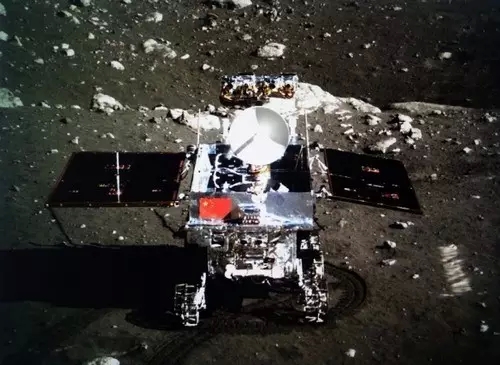APXS: new type of basalt discovered on lunar surface
China's lunar rover Jade Rabbit (also known as Yutu), launched as part of the Chang'e-3 lunar mission in 2013, has stopped operations on August 3rd. The Active Particle-induced X-ray Spectrometer (APXS), the only scientific payload on the robot arm of the Yutu Rover for the Chang’E-3 mission, has contributed to a discovery of a new type of basalt not known in the current sample collection on the lunar surface. The results were presented on the 46th Lunar and Planetary Science Conference in Texas, USA.
Since its successful landing on the Mare Imbrium in 2013, APXS has completed detection runs on two regions around the landing site three times. Seven major elements (magnesium, aluminum, silicon, potassium, calcium, titanium andiron) and four trace elements (chromium, strontium, ytterbium and zirconium) could easily be identified in the spectrum.
The release of the data has attracted the attention of research institutions worldwide. In collaboration with BAO, IGG, Notre Dame University, the University of Nanjing and the University of Shandong, IHEP scientists deduced the elements’ abundance from the APXS results.
The results showed that the CE-3 basalt can be classified as a mid-Ti, high-AL and low-K group based upon its chemical composition, which implies a type of basalt not found on the lunar surface before now. Meanwhile, joint observation with the Visible-Near Infrared Spectrometer (VNIS), panoramic camera and Lunar Penetrating Radar (LPR) revealed the landing site to be a young multilayered terrane.
Developed by the Institute of High Energy Physics and the Purple Mountain Observatory, Chinese Academy of Sciences, for the Chang’E-3 mission, APXS is a vital tool to provide valuable data for geochemical research on the moon.
APXS uses the X-ray fluorescence mechanism to determine elemental abundances of both soil and rocks along the traverse of the rover. The eight radioactive sources in the instrument excite the characteristic X-rays of the samples, then the X-rays are detected by the high resolution sensor to accumulate a spectrum, which can be used to deduce the presence and abundance of elements on the moon.
Because of its ability to identify and quantify element abundances, X-ray spectrometers are widely used for in-situ detection in extra-planetary missions. For example, APXS instruments were applied in the science payloads package for all the NASA Mars missions as geochemistry tools.
The IHEP research group dedicated several years to the functional design and performance verification of the instrument. This ensured the APXS was able to complete its in-situ detection mission and to guarantee the safety of the sensor, including protection against extremely low temperature during period of the moon night, and touching the security. The APXS was designed to have three work patterns which included the detecting pattern, the calibration pattern and the warm up pattern. The energy resolution of APXS is 135 eV@5.9 keV, which is the best resolution of any such similar instrument by far.
Research based on the CE-3 data is still underway. It is hoped that APXS instruments could play a role in further space missions such as lunar projects, Mars projects, asteroid projects, comet missions and so on, and to discover more mysteries in the geochemistry of extraterrestrial bodies.

Yutu rover of Chang’e-3 mission (image by Xinhua)

APXS (Sensor head, Radioactive Heat Unit and Inflight calibration target),image by IHEP